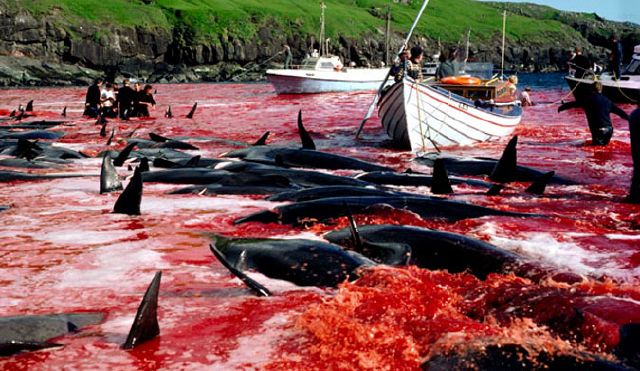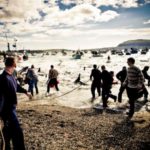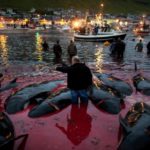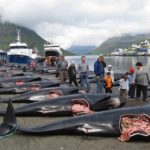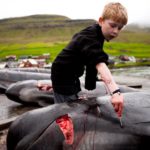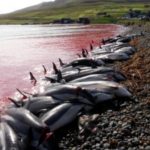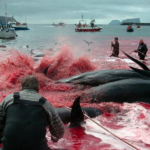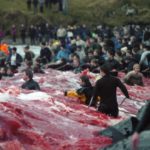THE HUNT
In the Faroe Islands whaling is a tradition and has been practiced since centuries. The hunts, called grindadrap in Faroese, are non-commercial and are organized on a community level. Anyone who has a special training certificate on slaughtering a pilot whale with the spinal-cord lance can participate.
The Grind law was updated in 2015, where one of the regulations demanded that the whalers followed a course on how to slaughter a pilot whale with the spinal-cord lance.
The hunters first surround the pilot whales with a wide semicircle of boats. The boats then drive the pilot whales into a bay or to the bottom of a fjord. Not all bays are certified, and the slaughter will only take place on a certified beach.
Many Faroese consider the whale meat an important part of their food culture and history, but OIPA claim that the harvest as being cruel and unnecessary.
HEALTH ISSUES
Pàl Weihe, scientist, have recommended in a letter to the Faroese government that pilot whales should no longer be considered fit for human consumption because of the high level of mercury and on the 2011 the Faroese Food and Veterinary Authority announced their reccomendation regarding the safety of eating meat and blubber from the pilot whale.
LOCATIONS
The location must be well suited to the purpose of beaching whales. It is against the law to kill pilot whales at locations with inappropriate conditions. The seabed must gradually slope from the shore out to deep water. Given such conditions, the chances are good that the whales can be driven fully ashore or close enough to the shore that they can be killed from land. When a school of pilot whales is sighted boats gather behind them and slowly drive them towards the chosen authorised location, usually a bay or the end of a fjord. There are 23 towns, villages or bays that have the right conditions and therefore legal authorization for beaching whales.
Since 1832, the Faroe Islands have been divided into several whaling districts. The catch is distributed in such a way that all the residents of the whaling district are given the same amount of the catch.
LEGISLATION
In recognition of the exceptional national, historical and geographical position held by the Faroes within the Realm, the Parliament of the Kingdom of Denmark, in conformity with the approval of the Parliament of the Faroes, has passed in 1948 the Act on the Home Government of the Faroes, which declares that the Faroes are a self-governing nation within the Danish State, in accordance with this Act.
Before the enactment of home-rule in 1948, the Danish governor has the highest responsibility of supervising a pilot whale hunt. Today, supervision is the responsibility of the Faroese government. The government is charged with ensuring that the pilot whaling regulations are respected and otherwise answer for preparations. In practice, this means that it is the local legislative representative who holds the highest command in a pilot whale hunt. It is his responsibility to both supervise the hunt and to distribute the catch.
Whale hunting equipment is legally restricted to hooks, ropes and assessing poles for measurement. Is not permitted to take whales on the ocean-side of the rope. A pilot whale drive is always under supervision of local authorities. The pilot whales that are not beached were earlier often stabbed in the bubbler with a sharp hook and then pull ashore. But, after allegations of animal cruelty, the Faroese whalers started using blunt gaffs in order to hold the beached whale steady and further more to pull the whales ashore by their blowholes after being killed. In 1985 the Faroe Islands outlawed the use of spears and harpoons.
Once ashore, the pilot whale is killed by cutting the dorsal area through to the spinal cord with a special whaling knife and after cutting it, the whaler must make sure that the whale is dead.
The length of time it takes for a whale to die varies from a few seconds to a few minutes. Other observers complained that it took up to fifteen minutes for certain whales to die, they noted several cuts were sometimes made before a succesful death and that some whales were not even killed properly until a vet finishes the job.

